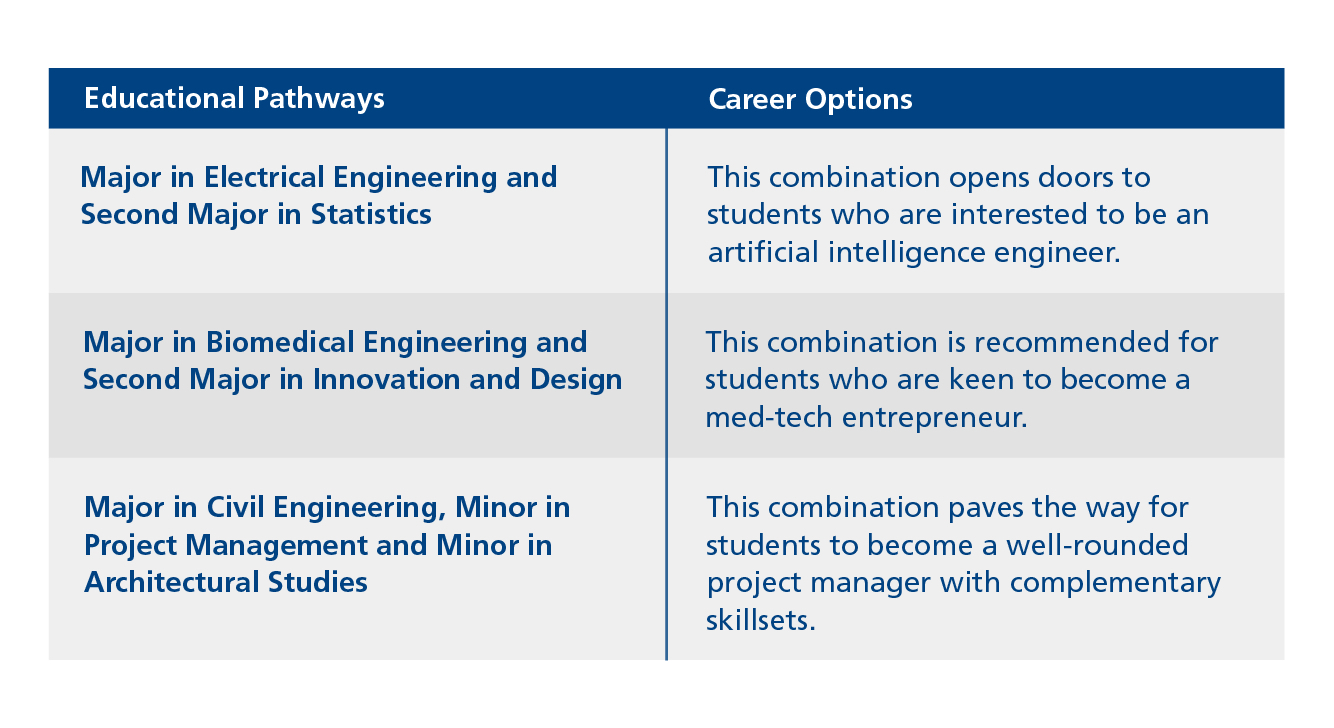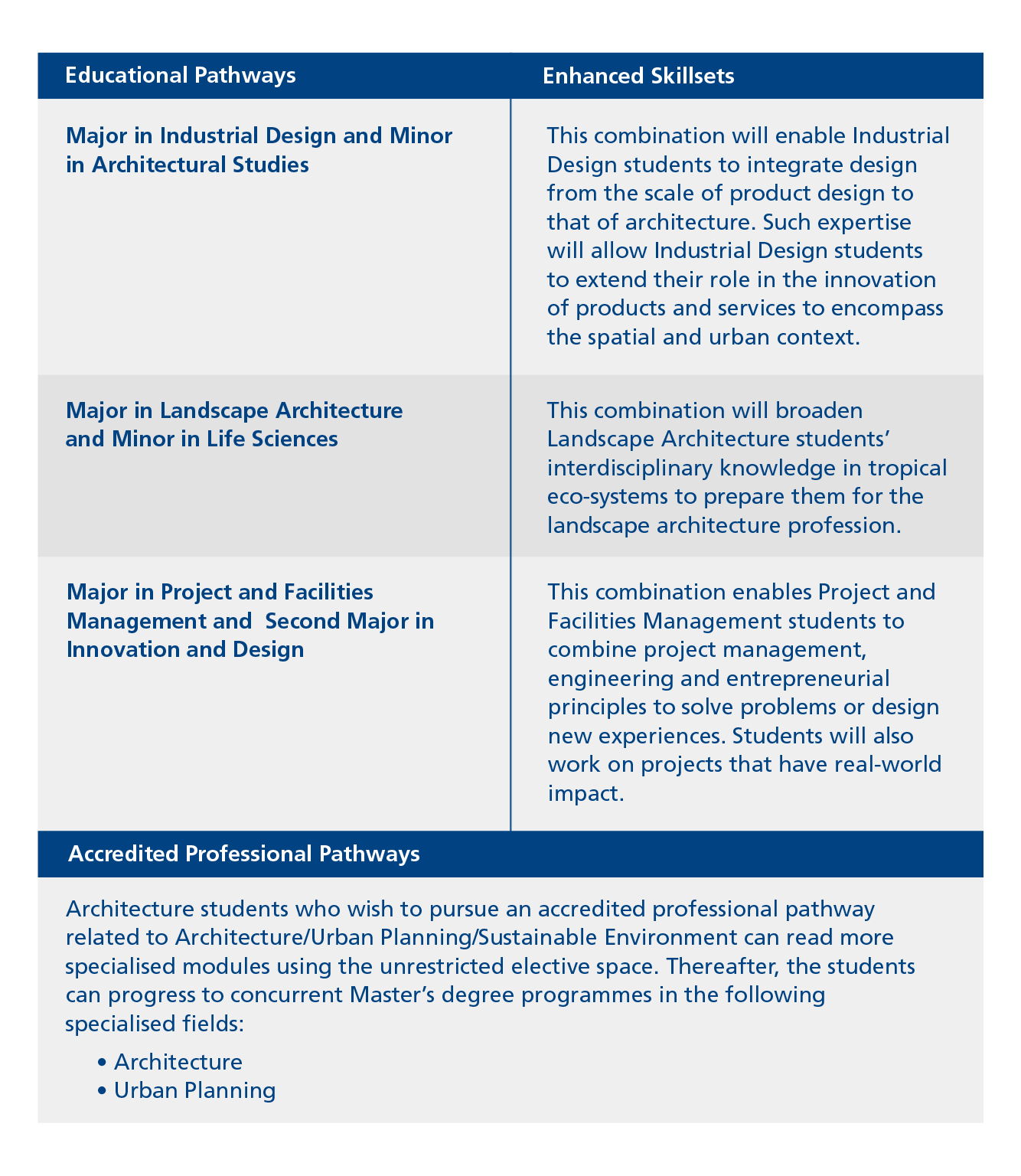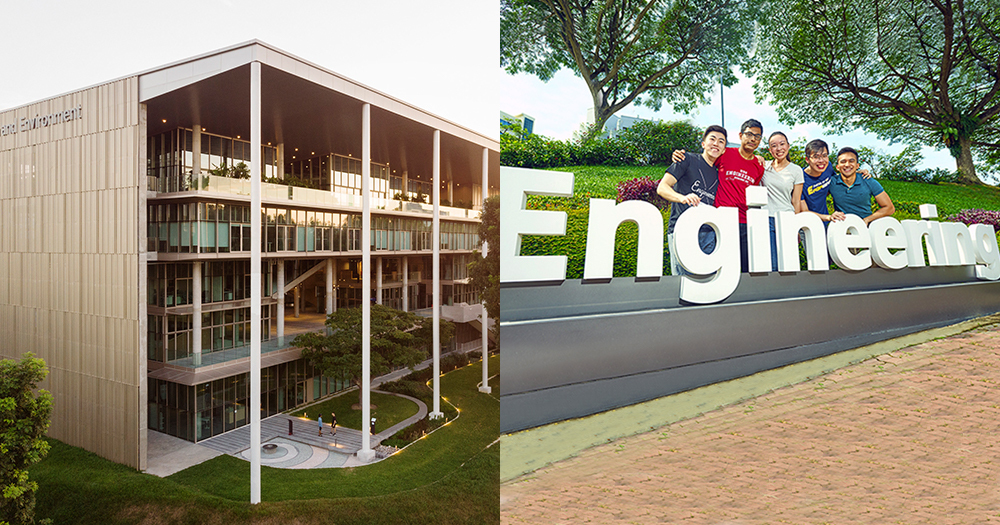The National University of Singapore (NUS) has recently announced that students enrolling in the Faculty of Engineering (FOE) as well as the School of Design and Environment (SDE) will be able to take courses from both schools starting from Aug. 2021 onwards.
What does this actually mean for students from the FOE and SDE?
Let’s imagine that you are Benjamin, an incoming student of the FOE who isn’t sure if he wants to work as an engineer in the future or explore other career pathways.
In the past, Benjamin would have to fulfil major programme requirements that usually comprise 67.5 per cent or more of his overall curriculum.
What this means is that he would be studying engineering-related subjects for the bulk of his degree, leaving little room for him to explore other areas of learning.
His course would also not readily allow second majors, or minor/specialisation combinations, which means that Benjamin’s skill sets, and therefore future career options, will largely be limited to that of his chosen major.
Come Aug. 2021, however, Benjamin will have the chance to build his own degree by combining the following:
- A common curriculum from both FOE and SDE (but more on this later)
- His chosen major in engineering
- A second major or
- Up to two minors
- Up to two specialisations
- A mix of electives within or outside his home faculty
- A combination of the above, e.g. one minor + one specialisation, one minor + electives etc
This way, Benjamin will get to enjoy greater choice, breadth and flexibility in charting his learning journey, on top of developing competencies across different fields.
The best part? He can complete all these and graduate with an Honours degree in four years.
For example:
- Major in Biomedical Engineering + Specialisation in Robotics + Minor in Public Health = Four years
- Major in Industrial Systems Engineering + Minor in Business Analytics + Minor in Quantitative Finance = Four years
That being said, Benjamin will continue to have the option of sticking to a traditional engineering degree track if he wishes to do so.
Similarly, if you are Stephanie, an incoming architecture student, you will get to enjoy a greater breadth of training in your degree.
Under the common curriculum, Stephanie will learn new skills such as artificial intelligence and systems thinking which will add value to her training in architecture.
She also has an option to choose a design-focused pathway or do a second major in another field, such as Innovation and Design offered by the Faculty of Engineering.
This will help her to acquire entrepreneurial skills and integrate her architectural design skills in areas such as healthcare, smart living, sustainable cities, and more.
Why is this new curriculum being introduced?
As the nature of work for engineers, designers and city-makers have changed and converged over the years, they now need broader training to do their job well.
“In our everyday life for instance, we are witnessing a convergence of engineering and design – sleek smart phones and consumer electronics, electric vehicles, as well as current net-zero and emerging net-positive energy buildings,” Professor Ho Teck Hua, NUS Senior Deputy President and Provost explains.
Because of this change, “we need a new generation of engineers, designers, urban planners, architects and built environment professionals who can work collaboratively across disciplines to find effective, integrated urban solutions,” acclaimed urban planner and architect Dr Cheong Koon Hean adds.
Dr Cheong is also the Chairman of the Centre for Liveable Cities under the Singapore Ministry of National Development.
As such, the undergraduate curriculum of both FOE and SDE has been significantly restructured to give students greater flexibility, more options for interdisciplinary learning and more hands-on opportunities to prepare them for future jobs.
What are the key changes in the new curriculum?
One key change is the introduction of a common curriculum that integrates knowledge and skill sets relevant to the professional training offered by both schools.
In this common curriculum, which was developed by a task force comprising six industry leaders - including Dr Cheong - and 10 NUS academics, new interdisciplinary modules will be offered.
These interdisciplinary modules aim to expose FOE and SDE students to real-world problems and give them practical, hands-on experiences.
For example, FOE and SDE students will read a module within the “Sustainable Futures” pillar under the tutelage of Professor Khoo Teng Chye, a leading expert in sustainable urbanisation.
This pillar raises students’ awareness of issues in the area of sustainability, highlighting the impacts of technology on the environment and society in both a local and global context.
They will also be exposed to related liveability issues such as diversity, accessibility, vibrancy, and resilience.
Another example would be the new interdisciplinary module called “Creating Narratives”, which aims to help students communicate competently and confidently in the various professional communication situations they encounter.
To help students experience more multi-level and multi-modal learning, their education is further complemented by:
- Internships
- Fieldwork
- Capstone and collaborative projects between FOE and SDE
When will this new curriculum start and what are the requirements for each degree?
FOE and SDE will adopt this new undergraduate curriculum for students starting in Aug. 2021.
This curriculum is designed to be flexible enough so that students can design their own degree programmes based on their passions, aptitude and career aspirations.
Let’s break down the requirements for each degree.
Students from FOE and SDE will have to read a total of 40 modules across four years, comprising:
- An equivalent of 15 modules in the common curriculum
- 15 modules in their selected major
- 10 modules as unrestricted electives
The modules in the common curriculum include the following:
6 General Education Pillars
- Communities and Engagement
- Critique and Expression
- Cultures and Connections
- Data Literacy
- Digital Literacy
- Singapore Studies
7 Common Pillars
- Artificial Intelligence
- Creating Narratives
- Design Thinking
- Maker Space
- Project Management
- Sustainable Futures
- Systems Thinking
1 Integrated Project
- Equivalent to two modules
Let’s imagine you are Angie, an FOE student.
Apart from being free to pursue a second major or minor across NUS, Angie will also be free to choose any specialisation accessible from her major.
What this means is that Angie can take a second major or up to two minors or specialisations within the curriculum space, without the need to increase her workload or extend her time in university.
For example:
- Major in Mechanical Engineering + Minor in Economics + Minor in Management = Four years
This degree combination could lead Angie, who might have previously been limited to careers related to mechanical engineering only, to management consultant positions.
What are some educational and career pathways under the new curriculum structure?
Here are some other examples of educational and career pathways for students in FOE and SDE under the new curriculum structure:
FOE

SDE
 This sponsored article by National University of Singapore made this writer miss studying for her degree.
This sponsored article by National University of Singapore made this writer miss studying for her degree.
Top image courtesy of NUS Faculty of Engineering and NUS School of Design and Environment. Photography by Rory Gardiner.
If you like what you read, follow us on Facebook, Instagram, Twitter and Telegram to get the latest updates.
